Worms in the human body are parasites that are not viable in themselves, they can survive and reproduce only through a host (human or animal). Parasitic diseases are caused either by the worms themselves in humans, or by their larvae. The disease is spread by infectious means, helminthic invasion often goes unnoticed, gradually causing disorders in the body.
First of all, you should understand what helminths are. This is the general name for worms that parasitize in the human body, in the bodies of animals or even plants. This explanation is also the answer to the question of what worms are. The terms "worm" and "helminth" are synonymous.
The most dangerous helminthic invasion is a long-lasting asymptomatic form, which leads to diseases caused by food deficiency. Intestinal parasites live by absorbing nutrients from the human body. Helminthic invasion can be detected at an advanced stage, after the appearance of other symptoms of the presence of intestinal parasites.
Some intestinal parasite larvae can reach different body tissues. In that case, inflammatory deposits form, because the immune system recognizes the larvae as foreign organisms. Some allergic reactions of the immune system can occur as a result of the presence of helminths in humans.
When worms appear in a person, the symptoms and treatment of the invasion are closely related to eliminating the cause of the discomfort, ie the parasite, and the signs of its presence also disappear.
Ways of parasite infection
There are many factors that cause worms to appear. Their appearance may be due to the following situations:
- one of the most common risk factors for helminthiasis is the impact of mass tourism;
- in second place is the contamination of water and food;
- helminths can be infected after eating meat products, sausages;
- poorly washed fruits and vegetables are the main source of parasite larvae;
- transmission of worms from pets is often recorded.
Symptoms of parasitic diseases
Worm infestations can manifest in different ways, depending on the type of parasite. The most common manifestations are the following:

- constipation - difficult bowel emptying caused by worms - is the result of blockage of intestinal flow;
- diarrhea - sparse stools occur due to exposure to substances secreted by parasites that cause loss of potassium and chloride;
- bloating and bloating - parasites cause inflammation and gas in the small intestine;
- muscle and joint pain - helminthiasis is often characterized by localization of worms even in joint fluids and muscle tissues;
- allergy - parasites perforate the intestinal walls, causing undigested molecules to enter the bloodstream, causing an allergic reaction;
- skin problems - helminthiasis often causes skin problems such as acne, rashes and itching;
- anemia - parasites stick to the intestinal mucosa and "steal" nutrients, leading to anemia;
- granulomas - a tumor focus is formed that surrounds the eggs of the parasite;
- nervousness - worms produce toxins that irritate the central nervous system, which can cause psychological signs;
- sleep disorders - nocturnal anxiety accompanies helminthic invasion for the following reasons: at this time the worms leave the rectum, the activity of the liver increases, which tries to get rid of the toxins they produce;
- chronic fatigue is one of the first signs of parasites in the body;
- oncological diseases.

Pinworms
Pinworms are among the most common intestinal parasites in the human body. These worms are scientifically called Enterobiusvermicularis. They are distributed all over the world. Despite the fact that these worms are primarily characteristic of the child's body and are most common in children's groups, they are also found in the adult population.
The infection occurs when the larvae of the parasite are swallowed, which are located anywhere in the environment of the infected person. They are present on the skin, under the nails, in bedding, clothing and dust. In the duodenum, larvae develop into adult parasites, after which they migrate to the colon.
Adult pinworms are about 1 cm long, thin, resembling white thread. They lay eggs in the perianal region. This is manifested by the most characteristic symptoms of the disease - discomfort and itching in the rectal area.
Complications of infection caused by parasites are chronic intestinal inflammation, in girls - a secondary vaginal infection.
2/3 of people infected with intestinal parasites are not aware of the presence of helminthiasis, as they often do not feel any symptoms other than anxiety, irritability and fatigue.
Vlasoglav
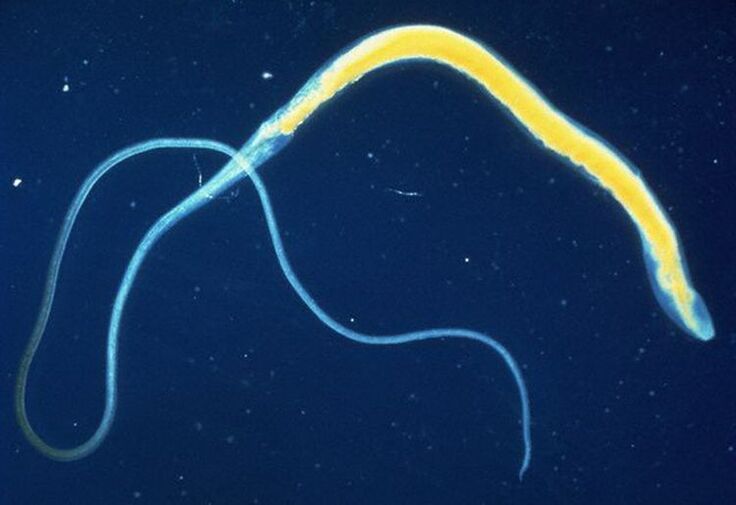
The second most common intestinal parasite is the whip, Trichuristrichiura. Infections caused by this type of worm are usually asymptomatic, which makes it difficult to accurately identify the infected person.
The adult whip is 3-5 cm long. . Worm infestation occurs orally - through the use of contaminated food or water, as well as through contaminated soil. The larvae of the parasite hatch in the small intestine, while the adult worms nest in the large intestine. The adult female lays eggs, which hatch with the feces and hatch in warm soil after 5 weeks of nesting.
In the worst case, the whip only causes abdominal pain, diarrhea or nausea. More serious complications of this infection occur exclusively in the tropics. In severe cases, chronic diarrhea or anemia may occur.
Nematodes
Human nematodes include 2 species of parasites - Ancylostomaduodenale and Necatoramericanus. Adult females are 10-13 mm (A. duodenale) or 9-11 mm (N. americanus), males 8-11 mm (A. duodenale) and 7-9 mm (N. americanus).
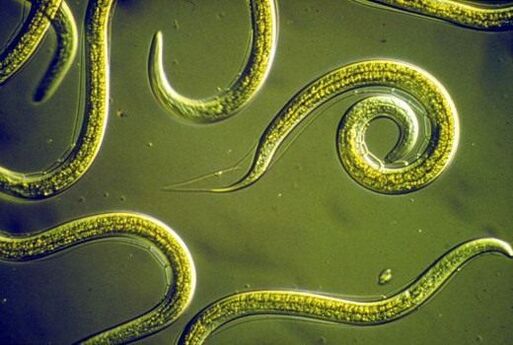
Eggs are excreted from the body of the host in the feces. In favorable conditions (humidity, heat), the larvae hatch within 1-2 days in the soil or in the feces, after 5-10 days they become larvae capable of transmitting the infection. They can survive in favorable natural conditions for 3-4 weeks.
Contact with the human body occurs through the penetration of parasite larvae through the skin. They reach the heart and lungs through the bloodstream, penetrate the pulmonary alveoli, then enter the pharynx from the bronchial tree, and the person swallows them. The larvae reach the small intestine, where they remain for as long as they need to develop into adult worms.
Adult worms live in the small intestine, attach to the intestinal wall and feed on the blood of their host, man. Most of these parasites are eliminated from the body within 1-2 years, but records of their parasitism in the body can reach tens of years.
The larvae of the A. duodenale worm that penetrate human skin are inactive (either in the intestines or muscles). In addition, parasitic A. duodenale infection can also be transmitted orally. However, the N. americanus worm requires migration.
Deer worm
Ascarislumbricoides are also intestinal parasites. The adult worm can grow up to 25 cm in length. Helminths in a person of this species remain hidden for a long time. Their symptoms are most often fatigue and cough, which in most cases is caused by other reasons.
It is enough to use unwashed vegetables and fruits for helminthiasis infection.
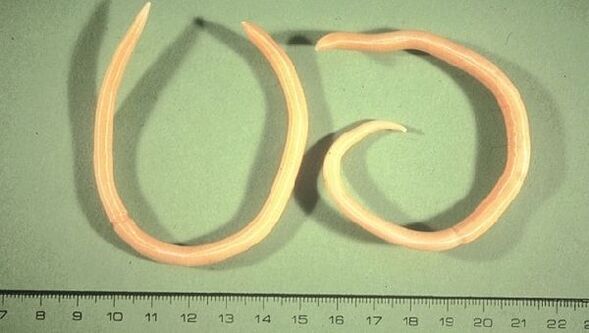
The larvae of these worms nest and hatch in the small intestine, penetrating the intestinal wall. Blood and lymph flow reach the lungs, causing coughing. When coughing, the greenish mucus clears, with which the roundworms return to the intestines after swallowing. Ascaris eggs are excreted in the feces.
The most common source of infection among humans is infected human feces.
In severe cases, ascaris can cause inflammatory processes in the body, most often pneumonia. But in most cases, people infected with worms remain asymptomatic or the symptoms are so mild that neither the patient nor the doctor initially suspects an intestinal parasite infection.
The disease caused by ascariasis is called ascariasis. The main route of infection is fecal-oral.
According to WHO estimates, the incidence of worms is about a billion infected people a year.
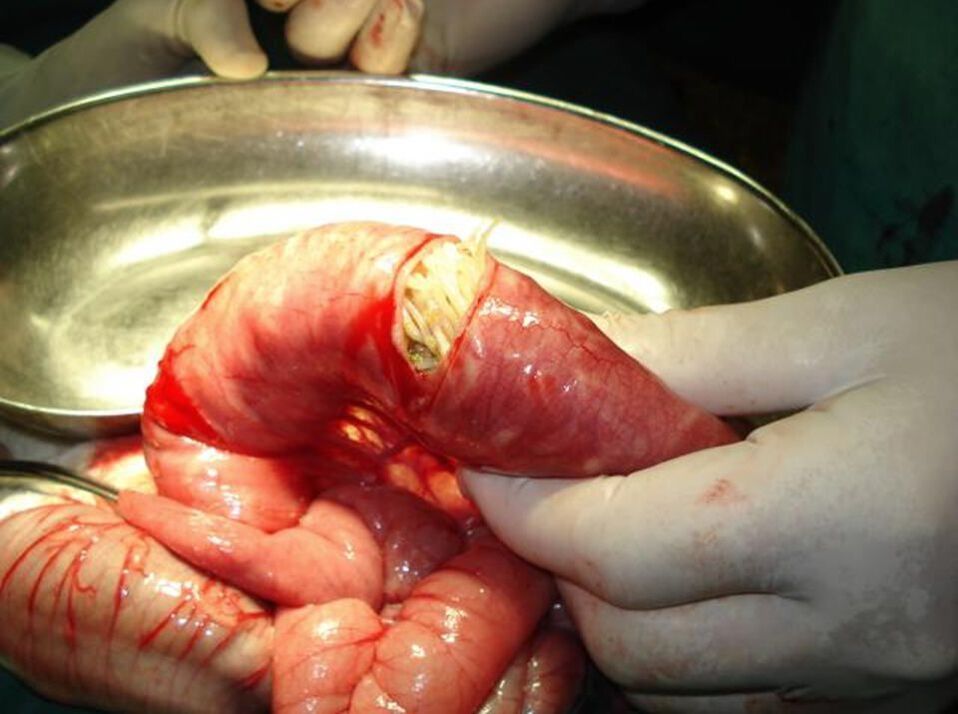
Helminths in adults, whose symptoms and treatment depend on the location of the worm, are characterized by various clinical manifestations - from asymptomatic forms to serious, even fatal cases. Common symptoms are discomfort and abdominal pain, diarrhea, rectal itching, or allergic manifestations. In the first - migratory - phase, the larvae of the parasite can cause signs of inflammation of the lungs (Loeffler's syndrome), pancreas, heart muscle, liver and other organs.
Worms in the intestines are the cause of metabolic disorders and disorders of the nervous system.
Ascaris in the respiratory organs
When worms migrate in the human body, they pass through the pharynx, where they colonize the lymph nodes around the main lymph chain (Waldeyer’s chain).
Where worm larvae may be present:
- lymph and salivary glands;
- pharynx;
- larynx;
- the area along the ear canals leading to the middle ear;
- all the passages that lead to the brain.
The lateral walls of the nasopharynx have openings leading to the Eustachian tube, which connects the pharynx to the middle ear. This allows the pressure in the ear to balance with atmospheric pressure. On these pathways, worm larvae can reach the middle ear. As a result, hearing deteriorates, tinnitus, headache and Meniere's syndrome appear - dizziness, followed by moments of memory loss.
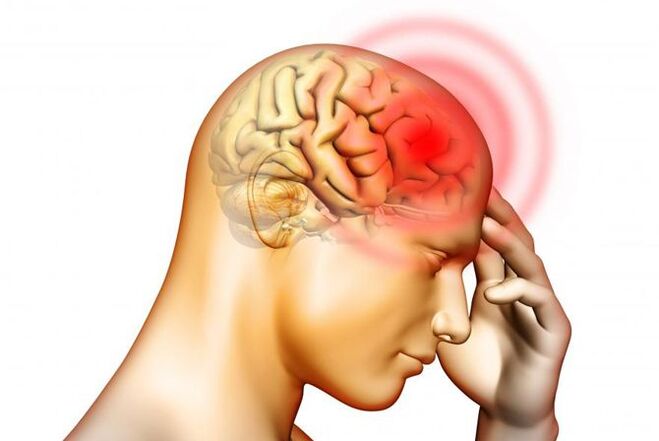
Pulmonary manifestations of ascaris
In ascarid lung lesions, diseases of this organ and skin signs in the form of roughness and rash appear. These symptoms are accompanied by a mild fever, but sometimes febrile conditions. The person suffers from dry cough, asthmatic bronchitis and hoarseness. Untreated pulmonary ascaris can develop into chronic problems with seasonal attacks and eventually cause severe bronchial asthma. A person becomes addicted to drugs, and sometimes even retires with a disability pension.
Worms in other organs
Due to the colonization of other organs by worm larvae, minor bleeding and signs of inflammation appear in them.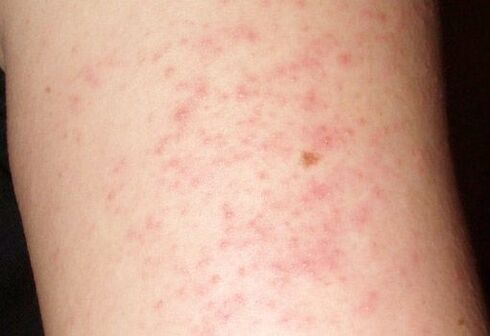 They are able to penetrate the pancreas, bile ducts and liver. In the small intestine, the larvae coalesce into a "lump, " causing ileus. The larvae of the parasite live in these organs throughout human life, feed on their metabolites and mechanically damage them.
They are able to penetrate the pancreas, bile ducts and liver. In the small intestine, the larvae coalesce into a "lump, " causing ileus. The larvae of the parasite live in these organs throughout human life, feed on their metabolites and mechanically damage them.
In the presence of larvae in the liver and bile ducts, the liver is weakened and cannot naturally excrete toxic substances. As a result, they are excreted through the skin, causing allergies, itchy rashes, subcutaneous swelling of "unknown" origin and other manifestations in many variants, from dry eczema to purulent processes.
Ascaris in the brain
The symptoms of cerebral invasion vary depending on where the worm larvae are present. If they are in the meninges, there is a risk of meningoencephalitis with migraine headaches. During the colonization of the grooves, granulomas form in the gray crust.
Later, the symptoms of cerebral cancer appear: loss of consciousness, epileptic seizures, convulsions. If the granuloma is located near the optic or auditory nerve, deafness or visual impairment occurs.
Tapeworm
The chain - Taeniasaginata, Taeniasolium - is one of the oldest and most well-known intestinal parasites. It can reach a record length - up to 9 m.
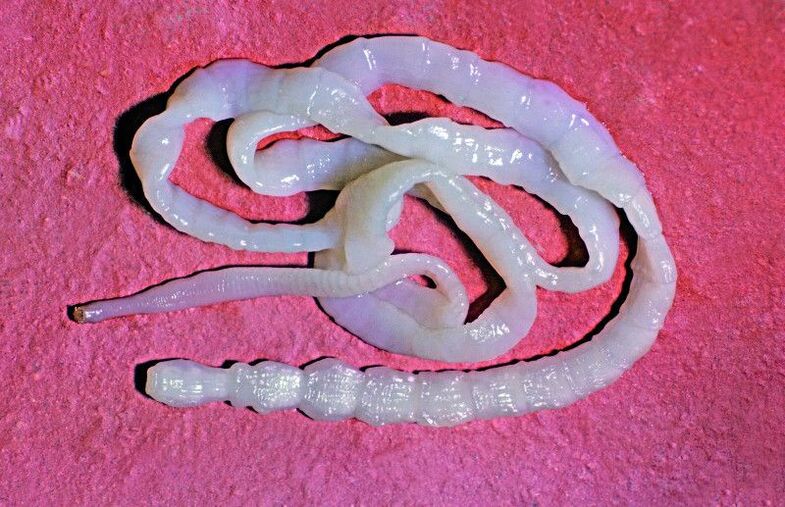
The two most common types of earthworms are bovine (Taeniasaginata) and porcine tapeworm (Taeniasolium). Both species colonize the body after consuming raw or improperly cooked meat. The eggs of the parasite are long and are deposited in the small intestine. Adult worms develop after 3 months. The end parts of the worm's body are filled with eggs, which are individually released and excreted in the feces. The larvae have the ability to enter the bloodstream through the intestinal mucosa and then migrate to the muscles and brain, where they inhabit.
Despite the severity of the disease, tapeworm does not necessarily immediately cause symptoms of its presence, so it remains invisible for a long time. The chain in the muscles causes pain in the muscles, in the brain - epileptic seizures.
The parasite is detected by X-ray or computed tomography. An accurate diagnosis can only be made on the basis of these studies.
Parasite treatment
Worm treatment methods are different. They also include the popular use of antiparasitic plants and state-of-the-art bioresonance therapy.
Antiparasitic plants
The rules of use of antiparasitic herbs are based on the localization of the worm in the body.

Reception half an hour before meals is recommended in the following cases:
- parasites in the intestines and lower body;
- secondary worm infection of the genitourinary system.
Use with food: damage from parasites of the stomach, colon, liver and spleen.
Use after meals: parasitic infestation of the upper body, lungs, neck, head.
Recommendations for the use of antiparasitic plants:
- not recommended for pregnant women;
- One of the most common anti-worm herbs, wormwood, should not be used for stomach ulcers.
Chemical antiparasitic drugs
The most effective drugs are those containing carbamic acid methyl ester. This active substance is intended for the treatment of pinworms, whips, roundworms, tapeworms. When treating pinworms, the dosing is carried out according to the instructions. Treat other parasites with these drugs according to age.
Adherence to the dose is important to avoid cramps.

Treatment using therapeutic frequencies on a bioresonance device and using a plasma generator
These devices destroy pathogens in the body without negative side effects. When using a bioresonance device, electrical impulses pass through the tissues, when a plasma generator is used - radio waves, which cause the parasite membrane to vibrate. The result is rupture of the membrane and, consequently, destruction of the parasite. A certain frequency is applied to each type of microorganism.
During this treatment of worms it is very important to adhere to the measures of the regime: the exclusion of alcohol consumption and subsequent detoxification. Dead worms must be removed from the body, otherwise they will be encapsulated and act as allergens.
All parasites present are eliminated by treatment with these methods. The therapy is carried out in 2 phases:
- stage 1: removal of small parasites - 20 minutes for each microorganism;
- Phase 2 - removal of large worms - first the frequency is applied to destroy the eggs, then the larvae and finally the adult worms.
Optimal therapy time:
- Unicellular: plasma - 5 minutes by frequency; bioresonance - 20 minutes by frequency.
- Multicellular: plasma - 10 minutes by frequency; bioresonance - 4 × 20 minutes using 1 frequency.
The use of a plasma generator, in addition to a significant reduction in the time of the procedure, has another great advantage - when used, up to 5 people can be present at the same time together with the animals. Its range is up to 5 m.
Conclusion
Worm treatment includes the elimination of sugar, sweet pastries and potatoes - these foods create an ideal environment for helminth survival.
In case of treatment of the child, it is recommended to give him roasted pumpkin seeds for chewing - about 30 seeds 3 times a day. They should not be eaten with main food.
Moderate eating of raw garlic will also help eradicate worms.
Getting rid of worms will not succeed without proper hygiene. Hand washing, frequent washing of bed linen, dishes is the basis of effective therapy.




























